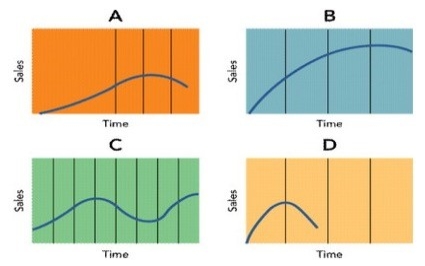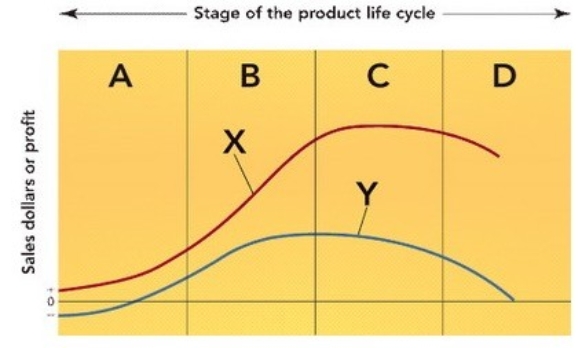A) the personification of a brand in terms of its benefits.
B) a brand name that cannot be spoken.
C) a set of human characteristics associated with a brand name.
D) the added value a brand name gives to a product beyond the functional benefits provided.
E) the embedded association between a company spokesman or paid celebrity and the product itself.
G) A) and B)
Correct Answer

verified
Correct Answer
verified
Multiple Choice
At which stage of the product life cycle are microwave ovens?
A) introduction
B) growth
C) maturity
D) decline
E) accelerated development
G) A) and D)
Correct Answer

verified
Correct Answer
verified
Multiple Choice
Which of the following products would have a fashion product life cycle curve?
A) skinny ties
B) parabolic skis
C) personal flotation devices
D) razor blades
E) hockey helmets
G) A) and B)
Correct Answer

verified
Correct Answer
verified
Multiple Choice
The consumers who adopt a new product in the earliest stage of a product life cycle are called
A) early adopters.
B) early majority.
C) late majority.
D) laggards.
E) innovators.
G) A) and D)
Correct Answer

verified
Correct Answer
verified
Multiple Choice
What is the marketing objective for the growth stage of the product life cycle?
A) minimize promotion
B) increase market share
C) stress differentiation
D) gain awareness
E) maintain brand loyalty
G) A) and D)
Correct Answer

verified
Correct Answer
verified
Multiple Choice
Brand extensions is the practice of
A) manufacturing a product under a new name that consumers will view as an entirely new product line.
B) manufacturing a new product with the same brand name for a new market segment in the same product class.
C) manufacturing accessory products for the base offering, such as Barbie clothes for Barbie dolls.
D) licensing another firm to manufacture modified versions of the original product.
E) applying the current brand name to enter a completely different product class.
G) A) and D)
Correct Answer

verified
Correct Answer
verified
Multiple Choice
Consumer advocates believe the practice of downsizing by consumer products firms has resulted in
A) lower product prices for consumers because of lower labor, raw material, and packaging costs.
B) a greener environment due to the reduction in the amount of packaging, thereby reducing the amount of waste disposed in landfills.
C) fewer product choices for consumers that led to rising prices.
D) keeping prices from rising in response to the psychological barriers consumers have developed for downsized products.
E) a subtle, deceptive, yet legal practice of disguising a price increase.
G) C) and D)
Correct Answer

verified
Correct Answer
verified
Multiple Choice
The practice of pairing two or more strong brands to facilitate the marketing of a joint product or service for their mutual benefit is referred to as
A) multibranding.
B) brand bundling.
C) co-branding.
D) mixed branding.
E) reseller branding.
G) A) and C)
Correct Answer

verified
Correct Answer
verified
Multiple Choice
The formula ________ is used to calculate CDI.
A) (Percent of the total U.S. population in a market segment ÷ Percent of a brand's total U.S. sales in a market segment) × 100
B) (Percent of a product category's total U.S. sales in a market segment ÷ Percent of the total U.S. population in a market segment) × 100
C) (Percent of a brand's total U.S. sales in a market segment ÷ Percent of the total U.S. population in a market segment) × 100
D) (Percent of the total U.S. population in a market segment ÷ Percent of a product category's total U.S. sales in a market segment) × 100
E) of the ratio of sales revenue of the firm to the total sales revenue of all firms in the industry, including the firm itself
G) C) and D)
Correct Answer

verified
Correct Answer
verified
Multiple Choice
 Figure 10-3
-The product life cycle shown in Box A in Figure 10-3 above is an example of a ________ product.
Figure 10-3
-The product life cycle shown in Box A in Figure 10-3 above is an example of a ________ product.
A) low-learning
B) fashion
C) fad
D) high-learning
E) generalized
G) C) and D)
Correct Answer

verified
Correct Answer
verified
Multiple Choice
When they were first introduced, peel-back aluminum seals were seen as a great alternative to using a traditional can opener to open cans because many people sliced their fingers with can openers. As soon as the technology became more widely available, many manufacturers switched to this safer, more flexible seal. This packaging innovation demonstrated the importance of a
A) functional benefit.
B) reseller benefit.
C) communication benefit.
D) perceptual benefit.
E) psychological benefit.
G) B) and E)
Correct Answer

verified
Correct Answer
verified
Multiple Choice
The ________ stage of the product life cycle is characterized by the slowing of total industry sales or product class revenue, causing marginal competitors to begin leaving the market.
A) decline
B) maturity
C) introduction
D) growth
E) deceleration
G) B) and E)
Correct Answer

verified
Correct Answer
verified
Multiple Choice
The lack of profit in the introductory stage of the product life cycle is very often the result of
A) pricing the product too low in an attempt to quickly gain market share.
B) targeting the wrong target market segment.
C) a lack of wholesaler support.
D) the large investment costs in product development.
E) ineffective execution of the marketing program.
G) All of the above
Correct Answer

verified
Correct Answer
verified
Multiple Choice
Private branding is also referred to as private labeling or
A) reseller branding.
B) generic branding.
C) multibranding.
D) co-branding.
E) multiproduct branding.
G) B) and D)
Correct Answer

verified
Correct Answer
verified
Multiple Choice
Trading down refers to ________ when repositioning a product.
A) reducing the number of features, qualities, or price
B) decreasing the amount of product carried as inventory
C) limiting the number of product items in a product line
D) redirecting marketing resources from a "cash cow" target market to one that is not performing as well in the hopes of increasing sales and profits
E) encouraging consumers through the use of coupons and deals to purchase a firm's lower-priced products
G) D) and E)
Correct Answer

verified
Correct Answer
verified
Multiple Choice
American Ninja Warrior began airing in 2012 on NBC during the summer season when TV ratings are normally low and network TV viewing options consisted primarily of reruns. The marketing goals for the first season on that network included making television viewers aware of the program's existence and generating enough excitement about the show so that millions of viewers would watch the athletic competition. At the airing of the first episode that year, American Ninja Warrior was in what stage of its product life cycle?
A) introduction
B) growth
C) maturity
D) decline
E) development
G) A) and D)
Correct Answer

verified
Correct Answer
verified
Multiple Choice
Footwear is an example of a ________ while men's dress shoes are an example of a ________.
A) product line; product class
B) product family; product line
C) product class; product form
D) product brand; product line
E) product form; product class
G) A) and B)
Correct Answer

verified
Correct Answer
verified
Multiple Choice
Kellogg's changed the name of its Heartwise cereal to Fiberwise most likely to
A) respond to a changing public interest from heart to intestinal health issues.
B) convey a stronger product image, since "heart" implied sentimentality and "fiber" implied strength.
C) comply with Food and Drug Administration guidelines on the use of the word "heart" in food brand names.
D) avoid a lawsuit by the maker of HeartPro Organic Cereal because it claimed the names and benefits were too similar.
E) complement its new line of breakfast fiber bars.
G) A) and D)
Correct Answer

verified
Correct Answer
verified
Multiple Choice
 Figure 10-1
-Figure 10-1 above represents the stages of the product life cycle. What does the curve labeled Y represent?
Figure 10-1
-Figure 10-1 above represents the stages of the product life cycle. What does the curve labeled Y represent?
A) total variable costs
B) total fixed costs
C) total industry profit
D) total industry sales revenue
E) total research and development costs
G) A) and E)
Correct Answer

verified
Correct Answer
verified
Multiple Choice
Procter & Gamble repositioned its Old Spice antiperspirant brand from a deodorant your grandfather might use to a strong, hip antiperspirant through commercials that showed the target market of 18- to 30-year-old men advocating its use. P&G used this product repositioning strategy with its Old Spice brand antiperspirant to
A) react to a competitor's position.
B) catch a rising trend.
C) change the value offered.
D) diversify its product portfolio.
E) reach a new market.
G) A) and E)
Correct Answer

verified
Correct Answer
verified
Showing 341 - 360 of 386
Related Exams